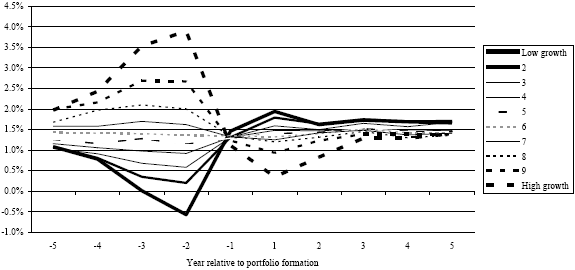Is firm total asset growth rate an independently valuable indicator of future stock returns? In their January 2009 paper entitled “The Asset Growth Effect in Stock Returns”, Michael Cooper, Huseyin Gulen and Michael Schill review the evidence for a strong asset growth effect in U.S. stock returns unexplained by other widely cited effects. Using firm fundamentals and stock return data for all non-financial U.S. public companies over the period 1968-2007, they conclude that:
- During 1968-2007, based on an equal weighting of stocks:
- A hedge portfolio rebalanced annually that is long (short) the stocks of companies with the lowest (highest) percentage growth in total assets over the previous 12 months generates an average annual return of 22% before trading frictions.
- On a risk-adjusted basis (market, size and book-to-market), this hedge portfolio generates an average monthly alpha of 1.1%.
- Low asset growth stocks outperform high asset growth stocks during 90% of calendar years.
- Over five-year holding periods, low asset growth stocks beat high asset growth stocks by an average cumulative return difference of 91%.
- This asset growth effect is stronger for small capitalization stocks, but is still substantial for large capitalization stocks.
- The effect is strongest in the month of January.
- Asset growth rate retains large explanatory power for future stock returns after accounting for firm size, book-to-market ratio and momentum. In fact the asset growth effect is at least as powerful in explaining returns as these other widely used factors.
The following chart, taken from the paper, shows the average monthly return from five years before to five years after portfolio formation for ten equally weighted portfolios formed at the end of each June during 1968-2006 from ten total asset growth deciles. The asset growth rate is the change in total assets over the most recently completed two fiscal years. There is a clear reversal in returns about six months before the time of sorting, such that high (low) asset growth firms with high (low) past returns tend to generate low (high) future returns. This reversal in returns is monotonic across asset growth rate deciles and approximately symmetrical.

In summary, evidence indicates that past firm total asset growth is a strong indicator of future stock returns, with low (high) asset growth indicating high (low) future returns. This asset growth effect is largely separate from size, value and momentum effects.
Cautions regarding findings include:
- Reported returns are gross, not net. Incorporating reasonable trading frictions from annual portfolio rebalancing and stock borrowing costs for the short side would reduce indicator performance. Shorting may not be feasible for all stocks in the short side.
- Calculating aggregate asset growth for a large sample of stocks and holding enough stocks for reliable exploitation may be problematic for investors, or costly if delegated.